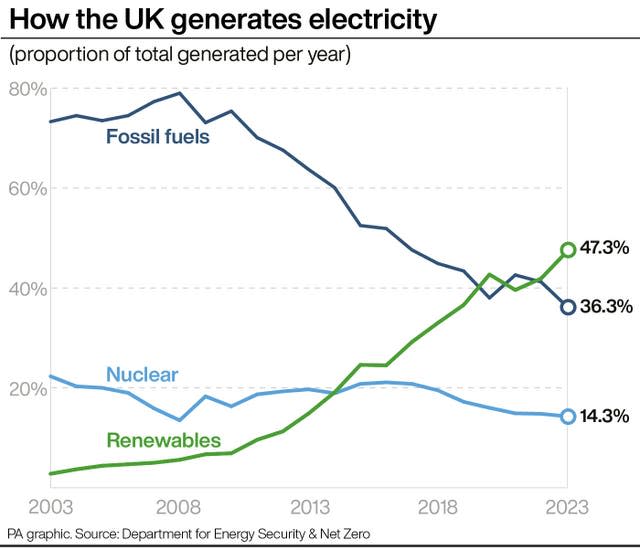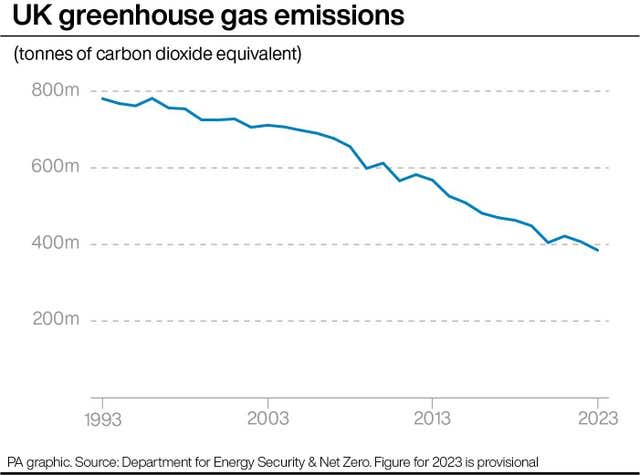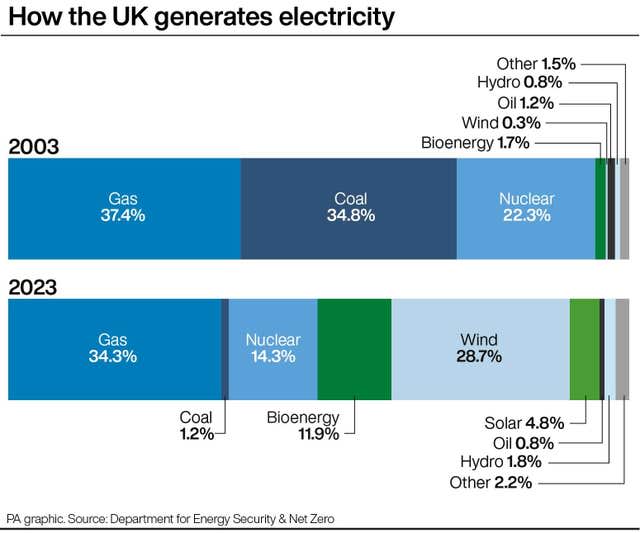UK records ‘highest ever share of electricity generation by renewables’
The UK recorded the highest ever share of electricity generation by renewables last year, Government figures show.
In energy trend data released on Thursday, the Energy Department (DESNZ) said this came as fossil fuel electricity generation saw its lowest ever share.
Renewable generation hit 135 Terawatt hours (TWh) in 2023, although this was broadly in line with 2022 levels as new capacity was offset by difficult weather conditions, DESNZ said.
But its share of overall generation increased to a record of 47.3% – up from 41.5% in 2022.
Renewables also set a quarterly record of 51.5% of UK electricity generation in the last three months of 2023.

This marks the first time more than half of all UK generation came from renewable sources.
Both records were “partially due to a fall in overall electricity demand and reduced domestic generation due to higher imports of electricity”, DESNZ said.
Energy prices hit record highs in late 2022 and did not start to fall until July 2023, forcing households and businesses to cut back on electricity use.
Meanwhile, UK imports “increased significantly in 2022”, DESNZ said, amid a rebound in French nuclear power output.
Less gas, which is the UK’s principal form of generation, was then needed to meet the remaining electricity demand in the UK.
So fossil fuel generation to a record low in 2023 – the lowest value since the 1950s – with its generation share shrinking to 36.3%.

Meanwhile, the total UK electricity generation fell 11.0% to 285.6 TWh in 2023 – the lowest value since 1983.
As fossil fuel electricity generation fell, wind generation’s share hit a record high of 28.7% in 2023, driving the overall record for renewables’ share.
More specifically, offshore wind saw a jump in its UK electricity generation share to 17.3% last year, compared to 13.8% in 2022.
A quarterly record was also set for offshore wind generation in the last three months of 2023, which was “largely driven by the 0.8 GW in new capacity,” DESNZ said.
Despite lower average daily sun hours across 2023, solar generation increased by 4.1% to 13.8 TWh, the figures show.

This total is the highest in the time series and reflects increased solar capacity, DESNZ said.
In contrast, nuclear generation fell by 15% to 40.7 TWh, a record low level due to reduced capacity and “all operational sites experiencing outages throughout 2023”, it added.
But despite this drop, low carbon generation – which includes renewables and nuclear – saw a record high share of 61.5% last year, according to the data.
The figures come as part of a trend which has seen renewables outperform fossil fuels for a third year.
Ana Musat, RenewableUK’s executive director of policy said: “These official figures show that renewables have outstripped fossil fuels yet again and provided more of the UK’s annual electricity needs than ever before, with wind leading the way as our biggest source of clean power.
“With renewables, we can strengthen Britain’s energy security with the cheapest sources of new power available for bill payers.
“That’s why we’re urging ministers to work with us to increase the number shovel-ready renewable energy projects which the Government could bring forward through this year’s auction for Contracts for Difference auction.
“This will enable us to maximise deployment, strengthen skills and grow new supply chains, as we continue to create jobs all around the country.”
The figures also showed that total UK energy production in 2023 hit a record low of 100.4 million tonnes of oil equivalent since the published series began in 1948.
This was also 66% lower than in 1999 when UK production peaked.

 Yahoo News
Yahoo News 
